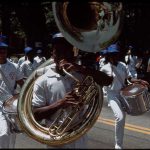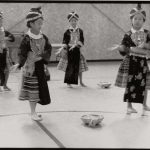Exhibition: Our Georgia, 1987–2007, Part One
Our Georgia, 1987–2007: Exploring the Georgia Traditional Arts Research Collection
Part 1: Talent, Tradition, and Community
Traditional arts are the expression of a community’s beliefs, values, and customs, all of which are influenced by that community’s location, history, language, religion, and other unique circumstances. Examples may include basketry, recipes, styles of music or dance, and festivals. “Folklife” or “folkways” are other terms that may be used to describe the forms these cultural expressions take.
Traditional arts take their name from their method of transmission: they are shared by one generation with the next in an informal manner, that is, outside of schools and classes.
As Georgia folklorist John Burrison notes, “Folklife is not static but fluid, constantly changing.” Tradition bearers pass on what they have learned, but their products and practices change as a community encounters new challenges and other cultures over time.
“Our Georgia, 1987-2007: Talent, Tradition, and Community” examines the objects and ideas represented in the Georgia Traditional Arts Research Collection, a project of the Georgia Council for the Arts, which was recently digitized and made available to the public through the Digital Library of Georgia. Gathered over a span of 20 years by 39 folklorists in the course of their work to connect traditional artists to Georgia Council for the Arts support in the form of grants and other opportunities, the collection consists of 15,540 images, 5,400 documents, and 431 audio and video recordings that document a range of people, communities, and traditional arts from 81 Georgia counties.
Who Are Georgians? What Does It Mean to Be a Georgian?
The collection captures an important period in Georgia’s history. The twenty years between 1987 and 2007 saw dramatic demographic shifts and events that brought into focus the need to reassess the answers to two critical questions: Who are Georgians? and What does it mean to be a Georgian?
Atlanta’s bid to host the 1996 Centennial Olympic Games shone a spotlight on the city’s―and the state’s―image, highlighting both the notion of southern hospitality and the changes that the civil rights movement brought about. Atlanta’s Hartsfield-Jackson International Airport became one of the world’s busiest, with direct flights to cities across the globe. The awarding of the Olympics led to much construction and opportunity for business development. Subsequently, Atlanta and Georgia grew in population. The answers to Who are Georgians? and What does it mean to be a Georgian? encompass more than black and white. The state’s Hispanic population expanded by 300% in the 1990s. The number of Asian immigrants, too, increased: Georgia’s Indian population alone grew by 200% during the 1990s. By the year 2000, 58% of Georgians were not native to the state, having emigrated from elsewhere in the United States or abroad. Such demographic shifts caused Georgians to reconsider the state’s identity.
The Traditional Arts Collection is an invaluable resource for understanding the lives and work of a diverse group of Georgians during this time of change. These digital exhibitions reveal an increasingly diverse state with a rich array of traditional arts.
Georgia’s Folklorists
At no moment in Georgia’s past were its folklorists better poised to capture the effects of these changes. African American folklife was notably recorded in the nineteenth and early twentieth centuries by Joel Chandler Harris, Charles C. Jones Jr., and the Savannah Unit of the Georgia Writers’ Project, but the late development of folklore as an academic discipline and the lack of an active state folklore society meant that there was limited documentation of Georgia’s traditional arts prior to the late 1960s.
The year 1966 marked a watershed moment for Georgia folklore, however; Georgia State University (known at the time as Georgia State College) integrated folklore into its curriculum, and Foxfire, an oral history project, was established at the Rabun Gap–Nacoochee School. By the 1970s, there were more folklorists at work in Georgia than at any prior time in the state’s history. In 1982–83 three Georgians were honored with National Heritage Fellowships by the National Endowment for the Humanities, further galvanizing the field. It was into this spirit of appreciation for Georgia’s folklife that the folklorists of the Georgia Council for the Arts set to work gathering the documentation comprising the Georgia Traditional Arts Research Collection—an effort that brought them into the homes, workplaces, and communities of their subjects.
Artists and Their Work
Georgians are and always have been a diverse group: they are urban and rural, young and old, long-time residents of the state and newly arrived. But for all their differences, they share a common desire to preserve a rich and varied cultural inheritance.
At the 1987 Sea Island Festival, Mary Green was recorded as part of a discussion about the foodways of her enslaved grandparents. She expressed hope that events like the festival could help people understand the cultural residue of slavery. In 1994 Nada Handać, a refugee from Bosnia, allowed her embroidery to be photographed. Green’s family had lived along the Georgia coast for centuries whereas Handać and her husband had only recently arrived in Lawrenceville. Despite these differences, by sharing their knowledge and talent, both women demonstrate how people maintain their identities through cultural practices and traditions.
Ritual and Custom in Secular and Sacred Communities
That traditional arts are learned through imitation and observation speaks to the significance of relationships in their transmission. Whether a single apprentice learns from a single master or a group of cousins learns from grandparents, community is key.
Consider, for example, the case of Hmong refugees, who settled in Georgia after providing assistance to the U.S. Army during the Vietnam War. Separated from their homeland and broader diaspora (of the approximately 60,000 Hmong people living in the United States in 1988, 873 were living in metro Atlanta), the community nevertheless sought to maintain its rich traditions. To that end, the Georgia Folklife Program and the Lao Family Community Association Inc. partnered to host a Hmong festival in 1988. Held in Decatur, the event brought the community together for music, games, dancing, a costume show, and food, exposing the younger generation to the practices and values of their people.
Just as Georgians are diverse, so too are their communities. Some, like the Hmong refugees, are bound together by region or national origin. Others are joined by faith.
A particular publicly celebrated cultural event with religious significance is the “blessing of the fleet” that occurs annually in coastal Georgia. Originating hundreds of years ago in southern Europe, where ocean fishing was a popular occupation, this tradition was brought to Georgia by Portuguese immigrants. In early summer a blessing ceremony, meant to ensure a safe and bountiful fishing season, and celebration take place in Darien and Brunswick. The event involves a Mass, procession of a statue of Our Lady of Fatima, blessing of passing boats, and judging of the boats’ decorations. The ceremony ends with the priest dropping an anchor made of flowers into the water to commemorate the fisherman in the community who have passed away.
Home altars allow individuals to worship privately. In 1989 folklorist Kay Turner curated an exhibition of home altars made by Mexican immigrants. Though not officially sanctioned by the Catholic Church, home altars are meaningful sources of comfort to those who create them. Their purpose is to secure a blessing from a patron saint. Altars usually feature at least one statue of a patron saint, family photos, candles, flowers, and milagros, tiny folk charms that represent the supplicant’s gratitude for blessings granted.
Cultural Continuity
As these and other examples demonstrate, communities rely heavily upon the traditional arts for cultural continuity and a connection to the past. Those who practice the traditional arts, while trained in methods developed in the past, work in the present and, as they consider the younger generation, are looking ever forward in anticipation of training a new generation.
Of the Hmong festival’s attendees, some certainly possessed clear and distinct memories of Laos. Others, as the photos illustrate, are young enough to have never known their parents’ and grandparents’ homeland. They may not experience a longing for a bygone time and place, but they can experience Laotian traditional arts for themselves. They can appreciate the music and costumes out of a reverence for their ancestors, or they may respond to them on a purely personal and aesthetic level.
While folklorist John Burrison acknowledges that the changes Georgia experienced in the twentieth century have impacted the practice of traditional arts and are closely related to Georgia’s diminishing agrarian society, he also cites the urban revivals of other forms such as Sacred Harp singing and folk pottery as examples of the enduring relevance of traditional art forms. One need only look to the proliferation of artisanal products and the state’s thriving maker culture for proof of their persistance. As always, immigrant groups continue to not only expand the variety of Georgia’s traditional arts but also provide new answers to the questions Who is a Georgian? and What does it mean to be a Georgian?
Sources and Further Reading
American Folklore Society website
Archbold, Annie, and Janice Morrill, eds. Georgia Folklife: A Pictorial Essay. Atlanta: Georgia Folklife Program, 1989.
Cobb, James C. Georgia Odyssey. 2nd ed. Athens: University of Georgia Press, 2008.
Georgia Traditional Arts Research Collection at Digital Library of Georgia
St. Simons African American Heritage Coalition website
Funding provided by Georgia Council for the Arts and the National Endowment for the Arts


























